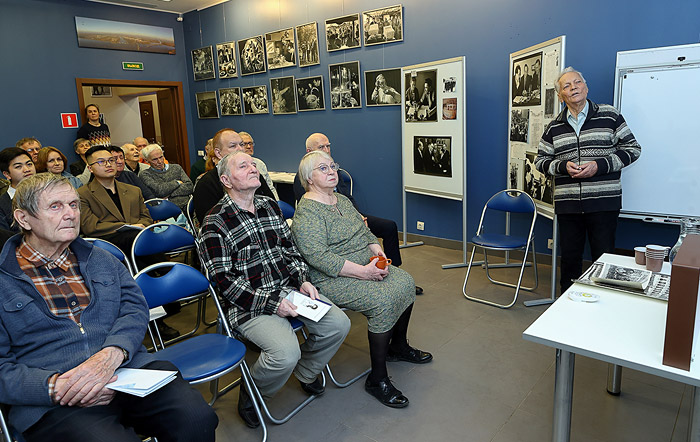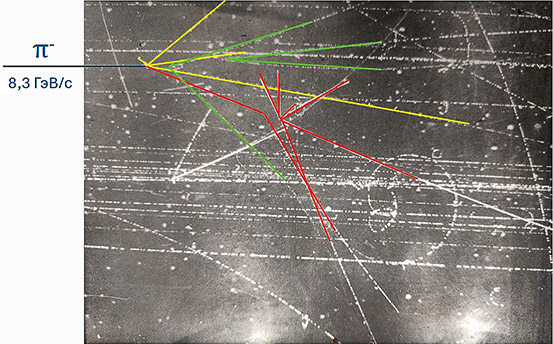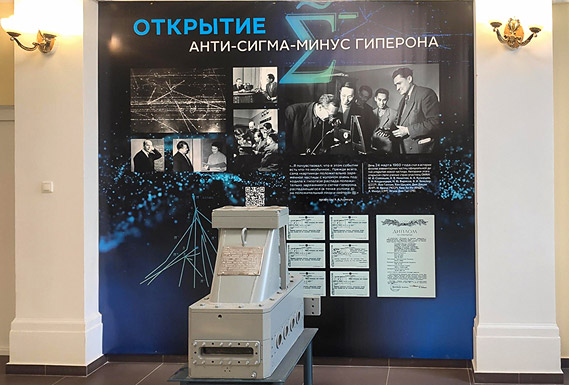
Electronic english version since 2022 |
The newspaper was founded in November 1957
| |
History in details
 Era, people, discovery
Era, people, discovery
On 31 March, the historical and memorial seminar "The discovery of the antisigma-minus-hyperon is 65 years old" was held at the Museum of History of Science and Technology of JINR. Initially, two reports were announced in the programme: "How it was - the event through the eyes of an eyewitness" by Vladimir A.Nikitin and "Authors of the discovery" by Alexander A.Rastorguev. But the circumstances were different. There were more speakers, as well as more details related to the discovery and its authors.
"After 65 years, we often hear - is there any point in wasting time on an event that is far in the past, especially since it is accidental and singular? Yes, indeed, it is accidental and singular, but it is there! Here is the point," chief researcher at VBLHEP Professor V.A.Nikitin started and suggested to look into the history of physics and to understand what preceded this discovery.
The story about Alexandrov, Blokhintsev, Kurchatov, about the development and launching of the legendary synchrophasotron in 1957 followed. Record size (with a diameter of 60 meters, size of a magnet block 7 meters in radius and 5 in height, with a weight of 36 000 tons), record energy - 10 GeV... Vladimir Alekseevich told about the principle of autophasing invented by V.I.Veksler and mathematically substantiated by E.L.Feinberg, the scheme of synchrophasotron operation.

The event that resulted in the discovery of the antisigma-minus-hyperon was recorded in a 24-liter propane bubble chamber while studying the interactions of negative pi mesons with energies greater than 8 MeV with hydrogen and carbon nuclei. The results of the interactions were photographed in three projections. Then, using a stereoloupe, the images were viewed and the required events were selected, track coordinates were determined, angles, impulses and velocities of the particles involved in the interaction were calculated. And then it was possible to identify which particles were produced as a result of the collision. In this way, 40 thousand images were analyzed, the whole group was involved in the viewing, but fortune smiled on A.A.Kuznetsov and V.G.Ivanov.
"On this day, I was supposed to be doing second-shift screening. Apparently, it was one of the days off, because there were only two of us in the room with Vladimir Germanovich Ivanov, an employee of the Laboratory of Nuclear Problems and there was an unusual silence. As a rule, this room was always crowded and very noisy on weekdays.
We were sitting at different ends of the room and each of us was doing our own thing: Vlad was counting something on the "Mercedes" and I was staring at the stereo-loop, looking through the tape left to me after the first shift. Sometimes, I would ask Vlad to come over to look at the picture of the event I had found and then we would discuss the correctness of its interpretation together. Vlad would easily disengage from his calculations and join in the discussion of my hypothesis with great interest.
It was repeated many times until I discovered the event that later pointed to the discovery of a new particle..." (from the memoirs of A.A.Kuznetsov)
It really turned out to be the production of a new particle. Almost two months were spent in careful analysis, repeated measurements and calculation of all trajectories. And when everything was double-checked, on 24 March, 1960, the manuscript of the future article "Birth of the antisigma-minus-hyperon using negatively charged pions with a momentum of 8.3 BeV/c" was sent to Moscow, to the scientific journal JETP. This day was considered to be the date of the discovery.

Afterwards, V.A.Nikitin "switched to the modern language", more precisely to the language of the Standard Model of particle physics and told about what this event is.
***
The report of A.A.Rastorguev, an employee of the museum, also began with the prehistory but from a different point of view: "This discovery was made practically at the last moment. It was made on 24 March and in the same year, the antisigma-plus-hyperon and antisigma-zero-hyperon were discovered. Just a little bit more and it would have happened in other scientific groups."
It was told about the scientific competition, first of all with the United States, about the long adjustment of the synchrophasotron to the required parameters, about how during this time other groups had discovered the antiproton and antineutron... The tension increased, in those days, mistakes were not forgiven. Discoveries justifying the construction of the synchrophasotron were eagerly awaited. In 1959, the first results obtained on the 24-meter bubble chamber were reported and as if a new particle had been discovered there, even a name was invented in honor of Dubna. But hopes were not realized. On 30 December, D.I.Blokhintsev wrote in his diary: "The KM has not yet been 'perfected' - this is the main problem of the future"... (KM was his old-fashioned name for the synchrophasotron).
And so, just a month after writing these lines, the long-awaited event was found! It is interesting that Anatoly Kuznetsov got into this scientific group only in autumn, 1959, contrary to Veksler's wish to leave him in the synchrophasotron operation group. It turns out that he came in autumn and in January, he already made a discovery.
А.A.Rastorguev told about all the authors of the discovery, more precisely, about all the facts related to these people that we managed to find. There are still many white spots in this story. For example, it is not clear why the list of authors originally consisted of 15 people (at least, they are listed in the first JINR Prize for 1961) but in the diploma of the discovery there are 13 names: В.I.Veksler, N.M.Viryasov, E.N.Kladnitskaya, A.A.Kuznetsov, A.V.Nikitin, M.I.Soloviev (USSR), I.Vrana (Czechoslovakia), A.Mihul (SRR), Kim Hee In (DPRK), Nguyen Din You (SRV), Wang Ganchang, Wang Tsutsen, Ding Datsao (PRC). That is, V.G.Ivanov and Chen Lingyan are absent.
Interesting facts were presented about Wang Ganchang - later he worked as a vice-director of JINR, and then, back home, he became a participant of the Chinese Atomic Project. Mikhail Iosifovich Soloviev was born in the Taldomsky district. Like many people of those times, he had an unusual life path: Kimr pedagogical school and immediately after graduation - the Great Patriotic War that for him ended in Prague, machine and tractor station, furrier's artel and only then, the Moscow State University Physics Faculty and the glorious path to science. The only woman among the authors, Evgenia Nikolaevna Kladnitskaya is mentioned in the diaries of writer Galina Nikolaeva that came to Dubna to collect matter for her books about physicists. And here is a photo of graduates of the Department of Accelerators of the Moscow State University Physics Department in 1958. Here are two classmates of the Nikitins - one is a co-author of the discovery, the other has just told the participants about this discovery. And several more people came to work at JINR: Yarba, Silvestrov, Pose, Golikov, Taran, Grishin, Lushchikov, Maltsev.
***
The participants of the seminar learned even more details from VBLHEP Scientific Secretary A.P.Cheplakov. At first, he told about the photo of the event itself - it is not a typical photo, it is of poor quality. By Alexander Pavlovich's admission, he would hardly have paid attention at that time to the kink that formed the antisigma-minus-hyperon. Rather, two forks indicating the birth of strange particles would have attracted his attention. Strangeness was then at the height of scientific interest. The listeners were given a glass plate to look at, onto which a historical photograph from the bubble chamber had been transferred.
An interview with D.I.Blokhintsev on 24 March, 1960, published in the newspaper "Pravda" was quoted: "About two decades ago, physics knew only five simplest, elementary particles, about the internal structure of which there was no information at that time. They were proton, neutron, electron, positron, photon. Today, our ideas about elementary particles have changed in many respects. Their "family" is replenished with more and more new members. Currently, there are already more than twenty of them." That is, in 1960, only 20 particles were known, so each discovery was a huge event.
А.P.Cheplakov presented archive photos, he managed to find images of all the authors. The leader of the scientific group was Van Ganchang, the relations between the scientists were very friendly, they helped each other in everything. Nguyen Dinh You, for example, came to JINR without knowing Russian and E.N.Kladnitskaya helped him in mastering literacy. The friendship lasted for many more years, the members of the scientific group met many times in Dubna and Kuznetsov, Kladnitskaya and Soloviev visited Van Ganchang.
The participants of the seminar learned a lot of interesting things about the bubble chamber technique, the history of development of this technique at JINR. For natural reasons, the chamber techniques were replaced by more current ones, fast and convenient in use. But still seminars are held on this subject and theses are defended. When the NICA complex will start operating, the speaker highlighted, every five seconds the statistics equal to that on which the antisigma-minus-hyperon was detected will be typed. And in 10-20 seconds - the statistics that the collaboration of the two-meter propane chamber has accumulated over all the years of operation. The JINR Topical Plan includes two items related to the analysis of data obtained in bubble chambers. The first one is "Search and investigation of a new charged particle in the mass interval 2-120 MeV". And the second is research on movie data processing. Today, the new technology allows us to quickly digitize the images and this huge volume of "underdimensioned" events will find its place in the new database. For the NICA science programme, this is a very good help.

A stand dedicated to the antisigma-minus-hyperon and legendary camera which the event was recorded in VBLHEP
To commemorate the discovery and the people that made it, a stand dedicated to the antisigma-minus-hyperon has been set up in the entrance hall of Building 3 of VBLHEP. The legendary camera which the event was recorded on is placed near it. Next to the stand is a wall of Military Glory with portraits of the Laboratory's veterans, participants of the Great Patriotic War. "They also contributed to the discovery, since they had constructed the accelerator and made a creative atmosphere," A.P.Cheplakov believes.
***
The next speaker was Nina Nikolayevna Sedykh, as she introduced herself, "daughter of Nikolay Viryasov, wife of Sergey Sedykh and mother of Georgy Sedykh". She spoke about the history of her family and gave the museum photographs, documents from the family archive and a portrait of Wang Gangchang. "The portrait was painted by my uncle, my mother's brother Vladimir Yushechkin," N.N.Sedykh said. "He collaborated with Dubna. The synchrophasotron projection shown on one of the slides is my uncle's work. In the 1960s, he was introduced to Wang Ganchang and he asked him to pose. The scientist posed once or twice and then my uncle completed this portrait using the photograph. Nina Nikolayevna gave the museum a number of other documents and photographs.
Daria Kladnitskaya, granddaughter of Evgenia Nikolaevna, shared an interesting fact: "I knew my grandmother, naturally, from the other side.... In addition to scientific work, she was engaged in social activities at the Institute and it was in front of my eyes in my childhood. For example, I remember, they fed the Dubna orphanage, when it was still there and the Taldom orphanage. My grandmother collected parcels for the children for big holidays. They traveled to them, bringing toys, books... She really liked to help people... My grandmother was from Serpukhov. And in the book of memories it is written that her parents were teachers of literature. But it doesn't say that her grandfather was a priest. And she was born in the house at the church, in the little wooden house of the batyushka..." This is how, after many years, the way of life of the seminar's heroes is explained and their deeds become clear.
The visitors of the museum learned a lot of details about people and scientific research on this day. And although the seminar was historical, scientific questions related to technologies and ideas about physics of those times were asked. And it is natural, because the seminars are attended not so much by those that know a lot but by those that like to increase their knowledge. And history benefits from this - in conversations, far from the rigor of formulae and proofs, evidence of the era, characters and unexpected turns of fate emerge.
Galina MYALKOVSKAYA,
photo by Igor LAPENKO